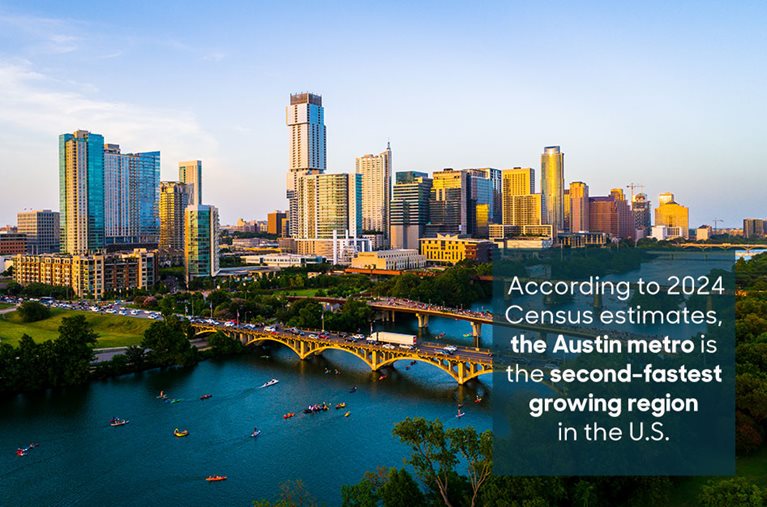
12 of the Best Neighborhoods in Austin (Including Austin Suburbs!)
Austin Texas
Welcome to Austin, the original home of keeping things weird — in the best possible way, of course. This vibrant city of over 974,000 residents has long been an artistic oasis in the middle of Texas. And it seems word has really gotten around. Whether you’re interested in the best neighborhoods in Austin or the best Austin suburbs, there are so many buzzworthy spots around this capital city.
| See how PODS makes Austin moving and storage a breeze. |
In fact, according to 2024 Census estimates, the Austin metro is the second-fastest growing region in the U.S. And it makes perfect sense. With the mouthwatering BBQ, loads of live music, plethora of outdoor activities, and the overall be-kind-and-be-yourself vibe, there’s a lot to love about this Central Texas city.
| This is the PODS Blog’s second article about Austin, TX. We cover the best neighborhoods and suburbs in the area and who they're best for here. If you’re looking for more information about making the move, the cost of living, the housing and job markets, or the best schools, check out the links below: |
The price for living in such a booming city, though? It’s probably not surprising that rent is soaring and the housing market is hot (the average home value is about $546,600, for reference).
Still, if you’re lucky enough to be moving to Austin but aren’t quite sure what neighborhoods or Austin suburbs to scope out, we’re here to help you narrow it down. We’ve lined up a quick tour of some of the best neighborhoods in Austin (including popular suburbs!). And we’ve taken all kinds of factors into consideration when evaluating these areas of Austin — overall vibe, convenience, things to do, and, yes, housing costs.
Wondering where to live in Austin, Texas? Buckle in, we’re headed to your next new ‘hood.
| Q: Is Austin, Texas, a good place to live? A: Austin, Texas, checks several boxes when it comes to what makes a city a great place to live. People who live here may have their gripes (temperatures do stay in the triple digits for months during the summer), but most residents find it to be a hip, quirky, and welcoming place to live. |
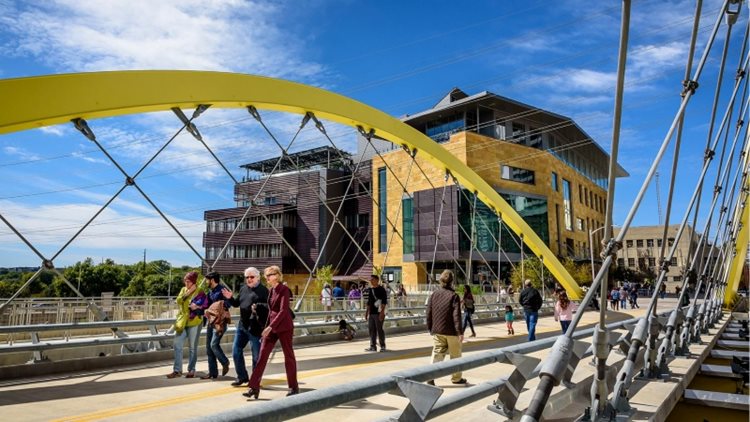
The mostly high-rise apartments and condos in Downtown Austin are more spacious than what you’d find in the heart of other metropolitan areas.
(Source: Downtown Austin via Facebook)
6 of the Best Neighborhoods in Austin, Texas
Looking for the best family neighborhoods in Austin? Best ‘hoods for singles? Students? Young professionals? Retirees? Wondering what are the best neighborhoods in Austin, TX, overall? We’ve taken housing costs, overall vibe, convenience, and things to do into consideration, so you can find the best area to live in Austin, TX, that’s perfect for you.
1. Downtown Austin
- Average rent (one-bedroom): $3,200
- Average home value: $740,800
- Great for: Young professionals, singles, college students, food and beverages, venues
For those who think of Texas as the Wild West, consider Downtown Austin the saloon. The raucous sounds of good times and live music pour out of the open windows and doors of the bars, restaurants, and venues lining the streets in Downtown Austin.
Living downtown is convenient and cool, but it’s especially fun for night owls — which makes this area one of the most desirable and coolest neighborhoods in Austin, particularly for wealthy college kids, young professionals, and singles looking to party. Downtown is also home to the Warehouse District, Austin’s unofficially official spot for loads of LGBTQ+ bars, nightclubs, and lounges.
You can also get a healthy dose of nature, thanks to a handful of green spaces and Lady Bird Lake, which borders downtown to the southwest. However, housing here costs nearly twice as much as elsewhere in the city. Most people living downtown rent — and shell out mega money for the privilege. Expect to pay over $3,200 a month on rent for a one-bedroom apartment, according to RentCafe data, nearly twice the $1,750 average rent price for the city. The upside (besides all the downtown perks)? The mostly high-rise apartments and condos here are still more spacious than what you’d find in the heart of other metropolitan areas, and they have some nice bells and whistles.
Things To Do in Downtown Austin
Don’t want a car or just prefer getting around on foot? Downtown Austin residents have a plethora of restaurants and entertainment within a five-minute walk on foot.
Here Are Some Highlights:
- Pick up breakfast tacos from Torchy’s Tacos
- Kill two birds with one stone by catching a show while chowing down on some BBQ at Stubb’s
- Watch the bats take flight under the Congress Avenue Bridge
- Take a walking tour to people-watch and admire all the architecture and historic buildings
| Q: What is the hippest neighborhood in Austin? A: Austin has a handful of hip neighborhoods, starting with Downtown Austin, North Austin, and South Austin neighborhoods. These areas are where you can find some of the city’s most eclectic boutiques, lively nightlife, art, and collection of good eats. |
2. Triangle State
- Average rent (one-bedroom): $2,500
- Median home value: $773,400
- Good for: Public schools, families, college students, jobs, nightlife, fitness, commuters
Also known as “The Triangle,” this Austin neighborhood is true to its name: The triangular area is defined by West 45th Street, North Lamar Boulevard, and Guadalupe Street. Just north of the University of Texas at Austin campus, the neighborhood of 3,300 or so residents is home to many students and young professionals, along with a slew of shops and restaurants, so you never have to travel far for a bite or some window shopping.
If you’re looking to invest in real estate, though, you may want to look in other nearby Austin neighborhoods. A whopping 96 percent of people that live in Triangle State rent, and there are rarely active home listings in the neighborhood. At around $2,500 for a one-bedroom apartment, rents here are higher than the city average (and include a nice selection of modern apartment buildings), but they’re well below the downtown Austin average rent of $3,200 — though it’s just a few miles north of downtown. The sheer convenience of commuting, compactness of the neighborhood, and lower rents compared to downtown are all among the reasons Triangle State ranks as the #1 best neighborhood to live in Austin, according to Niche.
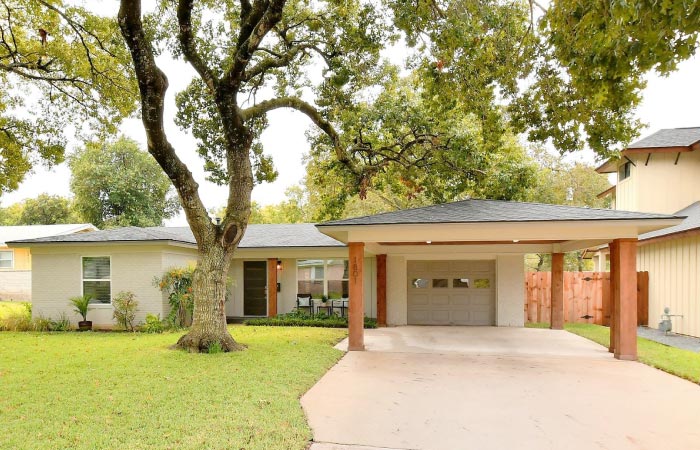
Crestview is one of the best neighborhoods to live in Austin with a nice urban-suburban vibe that is well worth checking out.
(Source: Juice Real Estate Group at Compass via Facebook)
3. Crestview
- Average rent (one-bedroom): $1,450
- Average home value: $644,300
- Good for: Public schools, families, jobs, nightlife, diversity, fitness, commuters
About 8 miles north of downtown Austin, Crestview is one of the best neighborhoods to live in Austin with a nice urban-suburban vibe that is well worth checking out, specifically for young families. Not only does Niche give it an A+ grade overall, but it also ranks as the #1 best neighborhood in Austin to raise a family. What’s so great about it? The public schools are highly rated, the neighborhood is highly walkable, and residents’ reviews tout everything from the kid-friendliness to the bar and coffee shop scene to the sense of community and the access to downtown.
People who live in Crestview are relatively split between houses and apartments, with 38 percent owning and 62 percent renting. The average rent for a one-bedroom apartment sits around $1,450 per data from RentCafe, a few hundred dollars below the city’s average rent price — making it one of the best neighborhoods in Austin to rent. And for those looking to buy, home values are hovering around $644,300, which is down a whopping 36.4 percent since last year.
4. Old West Austin
- Average rent (one-bedroom): $2,925
- Average home value: $942,300
- Good for: Public schools, families, jobs, nightlife, fitness, commuters
This Central Austin district is where you’ll find what may be one of the oldest (if not the oldest) trees in Austin: Treaty Oak. The massive tree is around 600 years old, and it has an exciting history, from an attempt to poison it to a confession to a heroic survival by the arbor that still stands today.
So, yes, you’ll find some great shade in the neighborhood, but you’ll also find lots of locally-owned businesses (with the exception of a Whole Foods), historic homes with front porches, gardens, and parks.
Bring your picnic blanket to Pease District Park, a green space complete with trails, a basketball court, a pond, and more. As you walk around, you’re sure to pass plenty of neighbors — Curbed dubs Old West Austin one of the best Austin neighborhoods for car-free living, and locals know the walkability is a major plus. It’s not hard to see why Niche ranks it as one of the top 10 best places to live in Austin.
Though some “McMansion” regulations have been placed on Austin’s older neighborhoods to prevent homes from being built too large and sold for too much, Old West Austin’s housing prices are still above average for the city. The neighborhood’s population of about 4,500 is relatively evenly split between renting (60 percent) and owning (40 percent). Renters pay an average of about $2,925 for a one-bedroom apartment, while the average home value comes out to around $942,300.
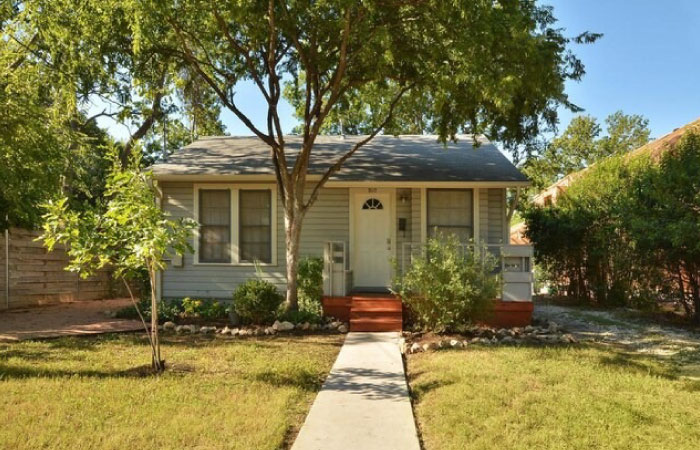
Homeowners are in the minority in Hyde Park, with about 74 percent of residents renting their homes.
(Source: Juice Real Estate Group at Compass via Facebook)
5. Hyde Park
- Average rent (one-bedroom): $1,775
- Average home value: $747,300
- Good for: Public schools, families, jobs, nightlife, fitness, commuters
The area’s relatively flat topography once made it perfect for horse racing, before it was converted into one of “Austin’s first suburbs” in the 1800s. Strolling through the leafy neighborhood now, you’ll note the 19th-century influence in the gorgeous Queen Anne Victorian homes and adorable bungalows that line the wide streets.
Homeowners are in the minority in Hyde Park, with about 74 percent of residents renting their homes at an average cost of about $1,775 per month for a 795-square-foot apartment, according to RentCafe. The 6,400-person population is an eclectic mix of families, students, and couples alike, making it no surprise that Niche ranks the Austin neighborhood as the third best in the city.
As for what to do in Hyde Park — one of the best neighborhoods in Austin — you can wander through the neighborhood’s many pocket parks; admire art for free in the Elisabet Ney Museum, a house museum of the eponymous German sculptor; spend an afternoon reading in one of the many local coffee shops; or grab some comfort food at the Hyde Park Bar & Grill, a restaurant housed in a 1920s-era home (don’t forget to snap a photo in front of the giant fork outside).
6. North Burnet
- Average rent (one-bedroom): $1,650
- Average home value: $250,400
- Good for: Public schools, families, jobs, nightlife, diversity, fitness, commuters
Ten miles north of downtown Austin, North Burnet is the fifth best neighborhood in the city, according to Niche. Nearly everyone who lives there rents, and the typical rent rings in below the Austin average at around $1,650 per month. Lots of singles and young professionals call this area home, and the population tends to be more liberal-leaning.
If you’re looking for something to do in this Central Austin neighborhood, check out The Domain, a stunning open-air shopping center. There are plenty of dining options on site, too — from bakeries and bubble tea to brick-oven pizza and a steakhouse. You can spend the whole day there, even into the night — the Rose Room is a three-level nightclub open until 2 a.m. on weekends, where you can dance the night away.
| Q: What is the best area of Austin, TX, to live in? A: That depends on your personal preferences, but some of the most popular neighborhoods to live in Austin proper are Downtown Austin, South Austin, East Austin, Central Austin, and West Lake Hills. |
6 of the Best Austin Suburbs
Now that we’ve covered some of the best neighborhoods in Austin, let’s take a look at some Austin suburbs that are well worth a slightly longer drive from downtown. Even if your zip code isn’t in ATX itself, there are plenty of good areas to live in Austin — that are actually outside the capital city itself.
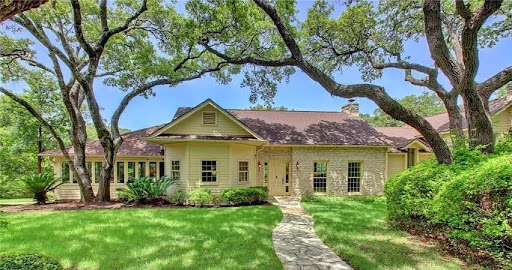
Niche rates West Lake Hills as the #1 place to retire in all of Texas, with its gorgeous views from the Hill Country to the southwest of Austin.
(Source: @elite25austin via Instagram)
1. West Lake Hills, TX
- Average rent (one-bedroom): $2,000
- Average home value: $2.16M
- Good for: Public schools, families, jobs, fitness, retirees
Hunting for the best place to retire in Austin? Niche rates West Lake Hills as the #1 place to retire in all of Texas, with its gorgeous views from the Hill Country to the southwest of Austin. It’s also one of the best Austin neighborhoods for families, thanks to a collection of great schools that often rank on “best schools” lists for the state. This suburb is often tagged as being overly wealthy, and the typical home value sits at more than 2 million dollars, according to Zillow. However, according to RentCafe, the average rent for a one-bedroom apartment is just under $2,000 a month — nearly on par with the city’s average of just over $1,700.
Here you’ll find busy days, quiet nights, and a tranquil vibe that appeals mostly to those families and retirees. Large estate homes and leafy streets, boutiques, and a lot of kid-friendly patio dining outfits this four-mile suburb that’s under 15 minutes from downtown Austin. And this is the kind of place where the Friday night high school football game is the event of the weekend. An extra bonus to award-winning schools, community vibes, and a relaxing atmosphere? The hilltop views of downtown Austin never get old.
| Q: What is the richest part of Austin, Texas? A: Situated just outside the western border of Austin, West Lake Hills and Rollingwood are two of the wealthiest areas and nicest neighborhoods in Austin, TX (or nearby, at least). The average home value in West Lake Hills is just over $2 million, while the average home value in Rollingwood is nearly $2.6 million. |
2. Rollingwood, TX
- Average rent (one-bedroom): $1,900
- Average home value: $2.6M
- Good for: Public schools, families, jobs, fitness
When it comes to public schools, Rollingwood aces the test. Niche gives it a series of impressive rankings, including:
- #2 in Places With the Best Public Schools in Texas
- #2 in Suburbs With the Best Public Schools in Texas
- #1 in Best Places To Raise a Family in the Austin Area
- #4 in Best Suburbs To Raise a Family in Texas
- #5 in Best Places To Raise a Family in Texas
With its A+-rated public schools, though, come some steep housing prices. Of the small population of about 1,500, a whopping 95 percent own their homes — and the average home value is around $2.6 million.
If you want easy access to the city without living right in the hustle of it all, Rollingwood is an excellent option. The Austin suburb is just four miles west of Downtown Austin, or an easy 10-minute drive, making it a highly convenient option for any young professionals with kids looking to live in an A+ school district while still having a breezy commute into the city.
If you choose to rent here, it’ll cost you around $1,900 a month for a one-bedroom, according to RentCafe. And if you’re buying, homes have an average value of around $2.6 million, according to Zillow (down 57.6 percent from the previous year).
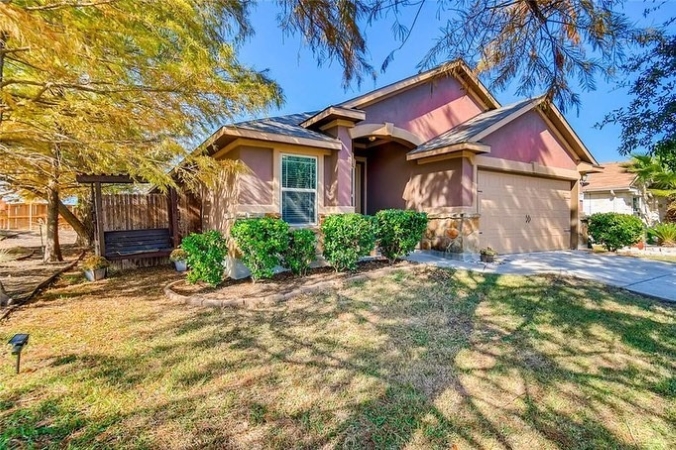
In some ways, Pflugerville feels like another hip, low-key but eclectic neighborhood inside Austin, even though it’s about 18 miles and 30 minutes north.
(Source: @atx_real_estate via Instagram)
3. Pflugerville, TX
- Average rent (one-bedroom): $1,600
- Average home value: $406,300
- Good for: Public schools, families, jobs, diversity, entrepreneurs, “Austin” feel
Unlike other suburbs of Austin, which tend to have moderate political views, folks who live in Pflugerville lean a little more to the left. The area’s been voted by Niche as the fifth best place to buy a home in the Austin area, and home values here are also rising in tandem with other Austin areas, averaging a little more than $406,000, according to Zillow. Looking to rent? You’ll get a bit of a break (compared to buying) with average rents around $1,600 a month for a one-bedroom, according to RentCafe, though it’s still surprisingly high for such a sparse suburban spot. At least the schools are good!
Pflugerville (which is pronounced “floo-grr-ville,” by the way) is full of entrepreneurial spirit and is a great place for young professionals. It’s also one of the best Austin neighborhoods for families who want good schools as well as the quirkiness and variety of Austin with a more community vibe. In some ways, Pflugerville feels like another hip, low-key but eclectic neighborhood inside Austin, even though it’s about 18 miles and 30 minutes north.
Even if you don’t move here, it’s worth a day trip to check out local Pflugerville tales on display at the Heritage House Museum, the top-shelf cocktails over at Spirit of Texas Brewstillery, and local favorites like Brotherton’s Black Iron Barbecue and Moi Vietnamese Grill.
| Q: What is the best suburb of Austin? A: Brushy Creek, TX, is the best of Austin suburbs, according to its #1 Niche ranking, thanks to its top-rated public schools, relatively affordable housing prices, and suburban feel that makes it a great place to raise a family. |
4. Brushy Creek, TX
- Average rent (one-bedroom): $1,625
- Average home value: $396,500
- Good for: Public schools, housing, families, jobs, diversity, fitness
If you’re looking for the best Austin suburbs, you’ll want to include Bushy Creek in your search — Niche has ranked it as the #1 best suburb to live in the Austin area, and it’s only about 20 miles north of the capital city. Not only that, but it’s the 10th best suburb in all of Texas, the 10th best suburb to raise a family in Texas, and the 18th best place to live in all of Texas.
Brushy Creek is home to a conservative-leaning population of some 22,300, most of whom (75 percent) own their homes. Housing affordability is one reason to start your home search here: The average home value of $396,500 is about $150,000 less than Austin’s average, and it’s gone down a whopping 46.2 percent in the past year. Not to mention it’s about $50,000 below the average home value of the neighboring Austin suburb of Round Rock.
The vibe here is young but family-oriented (the top-rated schools don’t hurt), making it a great pick for any young professionals with kids — especially those who want a close commute into Austin proper.
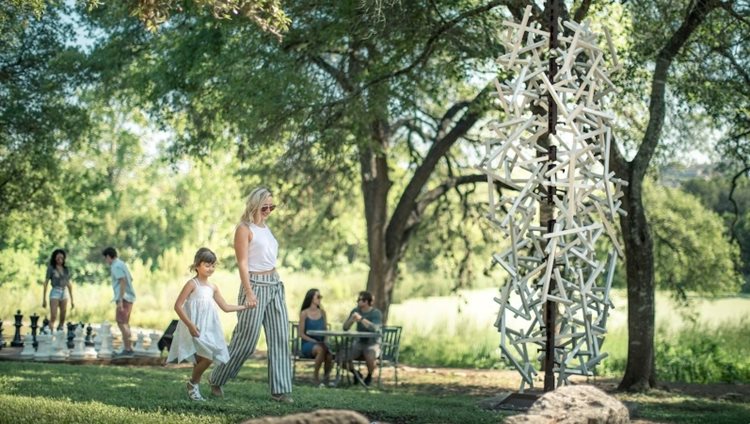
Don’t let Bee Cave’s small size fool you. This city is on the move, with a population that’s nearly doubled in the last 10 years.
(Source: Visit Bee Cave via Facebook)
5. Bee Cave, TX
- Average rent (one-bedroom): $1,925
- Average home value: $929,000
- Good for: Public schools, families, jobs, nightlife, diversity, fitness, suburban feel, country clubs
Looking for that small-town feel without giving up great nightlife options or diversity? Bee Cave might be just the right place for your new home. Located only 17 miles outside of Austin, covering a little more than 8.5 square miles and with just under 9,000 residents, Bee Cave is a much smaller town. It’s ranked by Niche as the sixth best place to raise a family in the Austin area, especially if you’re into that urban vibe in a suburban setting. Don’t let the small size fool you, though, as this city is on the move, with a population that’s nearly doubled in the last 10 years.
Still, given its size, there aren’t a lot of public school options, but thankfully they’re highly rated. However, the cost of living here may surprise you. Average monthly rent comes to about $1,925 for a one-bedroom apartment, according to RentCafe, and the typical home value is nearly $930,000, according to Zillow — a 41.8 percent decrease from 2023. While these costs are similar to what you’ll find in Austin, to be fair, property here is green and idyllic. And Bee Cave residents tend to be on the wealthier side, as evidenced by the area’s sprawling mansions and country clubs.
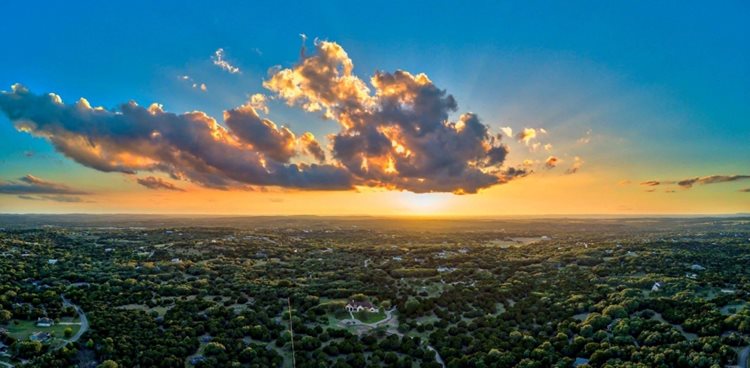
Dripping Springs brings in droves of out-of-town crowds, thanks to its popular breweries, wineries, and distilleries.
(Source: Destination Dripping Springs via Facebook)
6. Dripping Springs, TX
- Average rent (one-bedroom): $1,675
- Average home value: $741,900
- Good for: Public schools, families, jobs, fitness
If excellent schools and family-friendly features are at the top of your list, Dripping Springs is your spot. This very small town is about 25 miles and 40 minutes west of Austin and has just over 7,000 residents. The vibe is quiet and rural while still being within an easily accessible distance from the big-city amenities of Austin. Dripping Springs’ biggest claim to fame? It’s where Willie Nelson was inspired to create his inaugural 4th of July Picnic.
According to Zillow, the average home value in Dripping Springs is around $41,900 — a 47.6 percent decrease from the previous year), and RentCafe tags average rent here at about $1,675. But most people living here are fine exchanging a higher-than-average cost of living for a strong community, complete with local events, top-notch schools, and wholesome feel-good staples like a farmer’s market and the library in the town center.
Even if you don’t choose to live here, you’ll probably end up visiting, though. Dripping Springs brings in droves of out-of-town crowds, thanks to its popular breweries, wineries, and distilleries. Plus, if you’re looking for the best pastrami sandwich in the Austin Metro Area, it’s here, at Pieous.
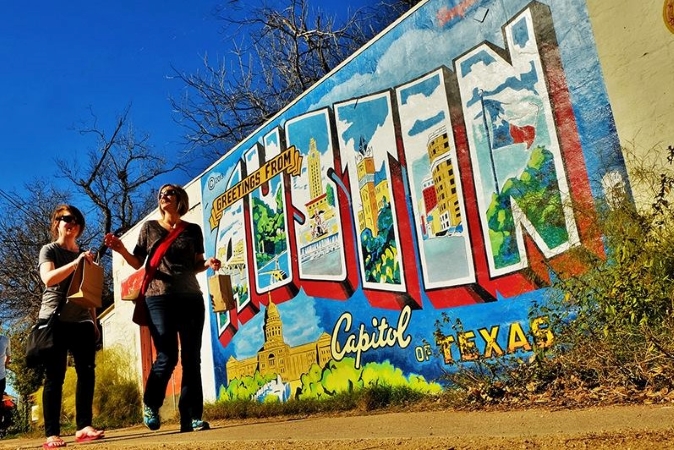
When you finally roll into Austin, don’t forget to keep things weird.
(Source: Visit Austin, Texas via Facebook)
Planning Your Move to Austin
We hope we’ve helped narrow down the choices for your new Austin neighborhood or suburb and shown you a little about what living in Austin, Texas, would entail. Now’s a good time to start getting ready for your move. Here are some additional resources from the PODS Blog that are ideal for the early stages of planning a move:
- 8 Insanely Clever YouTube Videos To Help You Declutter
- Moving Tips: We Answer Your Top Questions
- Self-Moving 101: How To Save Money and Avoid Stress
And when you finally roll into Austin, don’t forget to keep things weird.
Alex Keight is a writer who has lived — and moved — all over the country and the world. She is an expert at packing, whether it’s for a long-distance move or a short weekend trip. When she’s not writing or on the move, Alex spends her time giving her cat booty pats, cooking up dishes in the kitchen, and buying way more books than she knows she’ll ever actually get to reading.
Editor’s note: For ease of reading, monthly rental prices were rounded to the nearest $25 and home values were rounded to the nearest $100.
Related Articles
Comments
Leave a Comment
Your email address will not be published. Required fields are marked *
